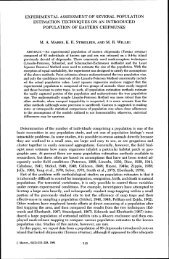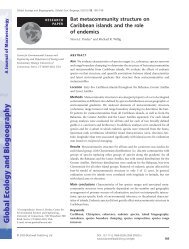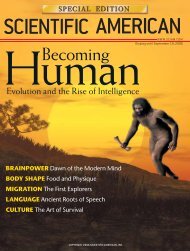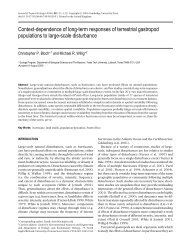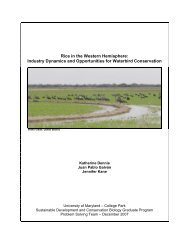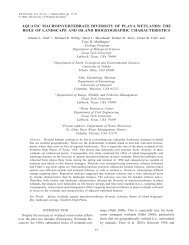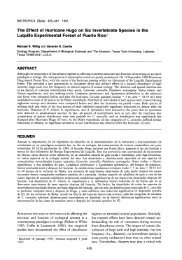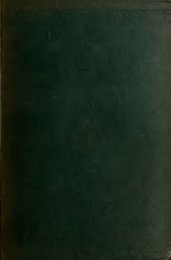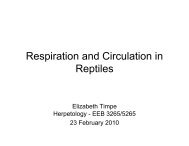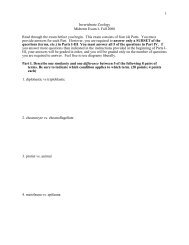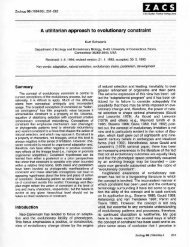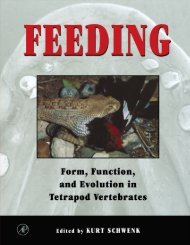Tadpole shrimp structure macroinvertebrate communities in playa ...
Tadpole shrimp structure macroinvertebrate communities in playa ...
Tadpole shrimp structure macroinvertebrate communities in playa ...
Create successful ePaper yourself
Turn your PDF publications into a flip-book with our unique Google optimized e-Paper software.
Hydrobiologia (2005) 541: 139–148 Ó Spr<strong>in</strong>ger 2005<br />
DOI 10.1007/s10750-004-5033-6<br />
Primary Research Paper<br />
<strong>Tadpole</strong> <strong>shrimp</strong> <strong>structure</strong> <strong>macro<strong>in</strong>vertebrate</strong> <strong>communities</strong> <strong>in</strong> <strong>playa</strong> lake<br />
microcosms<br />
Susan Harrell Yee 1,2, *, Michael R. Willig 1 & Daryl L. Moorhead 1,3<br />
1<br />
Department of Biological Sciences, Texas Tech University, Lubbock, Texas 79409-3131, USA<br />
2<br />
Present address: Department of Ecology and Evolution, University of Chicago, Chicago, IL 60637, USA<br />
3<br />
Present address: Department of Earth, Ecology and Environmental Sciences, University of Toledo, Toledo, Ohio 43606,<br />
USA<br />
(*Author for correspondence: Tel.:+1-773-834-7690, Fax:+1-773-702-9740, E-mail: harrell@uchicago.edu)<br />
Received 20 August 2004; <strong>in</strong> revised form 9 October 2004; accepted 16 October 2004<br />
Keywords: diversity, ecosystem eng<strong>in</strong>eer, <strong>in</strong>vertebrate community, microcosms, <strong>playa</strong>s, predation, species <strong>in</strong>teractions,<br />
Texas, Triops longicaudatus<br />
Abstract<br />
Laboratory microcosms were used to assess whether tadpole <strong>shrimp</strong>, Triops sp., affect community <strong>structure</strong><br />
of other native <strong>macro<strong>in</strong>vertebrate</strong>s <strong>in</strong> <strong>playa</strong> lakes of the Southern High Pla<strong>in</strong>s of Texas. Removal of tadpole<br />
<strong>shrimp</strong> shortly after hatch<strong>in</strong>g reduced abundances of many taxa, and decreased subsequent taxonomic<br />
richness and diversity. For many <strong>in</strong>vertebrates, the presence of tadpole <strong>shrimp</strong> <strong>in</strong> low numbers had a<br />
positive effect on mean abundance. Direct effects of tadpole <strong>shrimp</strong> <strong>in</strong>clude the reduction of prey species<br />
abundance, which <strong>in</strong> turn may alter biotic <strong>in</strong>teractions among other taxa. Indirect effects <strong>in</strong>clude physical<br />
modification of the environment dur<strong>in</strong>g forag<strong>in</strong>g through surface sediments. Results suggest that tadpole<br />
<strong>shrimp</strong> may be a key species controll<strong>in</strong>g <strong>structure</strong> of <strong>macro<strong>in</strong>vertebrate</strong> <strong>communities</strong> <strong>in</strong> <strong>playa</strong> lakes.<br />
Introduction<br />
Biotic <strong>in</strong>teractions, such as competition, predation,<br />
and mutualism (Pa<strong>in</strong>e, 1980; Abrams et al.,<br />
1996), as well as environmental factors such as<br />
habitat <strong>structure</strong> or light availability (Jones et al.,<br />
1994) can have profound effects on community<br />
<strong>structure</strong>. If regulatory effects are l<strong>in</strong>ked strongly<br />
to a particular taxon, the loss of such a species<br />
may greatly alter the characteristics of the community<br />
(Pa<strong>in</strong>e, 1980; Power et al., 1996).<br />
A species may simultaneously occupy a variety<br />
of functional roles that affect a community (Chap<strong>in</strong><br />
et al., 1997; Tilman et al., 1997). For example,<br />
predators may determ<strong>in</strong>e community composition<br />
through preferential feed<strong>in</strong>g on particular prey<br />
species (Sih et al., 1985; Thorp, 1986), or may<br />
enhance diversity by prevent<strong>in</strong>g competitive<br />
exclusion by dom<strong>in</strong>ant prey species (Pa<strong>in</strong>e, 1969,<br />
1992). Indeed, predation is an important determ<strong>in</strong>ant<br />
of community <strong>structure</strong> <strong>in</strong> freshwater systems<br />
(Brooks & Dodson, 1965; Dodson, 1974; Hebert &<br />
Loar<strong>in</strong>g, 1980; Zaret, 1980; Mor<strong>in</strong> et al., 1983;<br />
Black & Hairston, 1988). Alternatively, a species<br />
may affect community <strong>structure</strong> by modify<strong>in</strong>g the<br />
environment. Such disturbances create different<br />
habitat patches which have an effect on many<br />
population and community characteristics (Jones<br />
et al., 1994; Lawton & Jones, 1995; Willig &<br />
McG<strong>in</strong>ley, 1999).<br />
The common tadpole <strong>shrimp</strong>, nom<strong>in</strong>al species<br />
Triops longicaudatus (see Murugan et al., 2002),<br />
may exert such effects on <strong>macro<strong>in</strong>vertebrate</strong> community<br />
<strong>structure</strong> <strong>in</strong> ephemeral <strong>playa</strong> lakes,<br />
important centers of biodiversity on the Southern<br />
High Pla<strong>in</strong>s of West Texas (Bolen et al., 1989;<br />
Haukos & Smith, 1994; Hall et al., 1999, 2004).<br />
Playa lakes are shallow bas<strong>in</strong>s with essentially
140<br />
impermeable floors that usually collect water<br />
dur<strong>in</strong>g early spr<strong>in</strong>g ra<strong>in</strong>s and desiccate <strong>in</strong> late<br />
summer or fall (Haukos & Smith, 1994; Anderson<br />
& Smith, 2004). Because <strong>playa</strong>s are ephemeral,<br />
many resident <strong>in</strong>vertebrates lack<strong>in</strong>g autonomous<br />
means for emigration have evolved specialized life<br />
cycles and physical adaptations for surviv<strong>in</strong>g<br />
drought (Belk & Cole, 1975; Wigg<strong>in</strong>s et al., 1980;<br />
Pennak, 1989; Anderson & Smith, 2004). For<br />
example, the rest<strong>in</strong>g cysts of branchiopods and<br />
diapaus<strong>in</strong>g eggs of ostracods require environmental<br />
stimulus to eclose, such as changes <strong>in</strong> oxygen<br />
concentration, light, or temperature, which occur<br />
when <strong>playa</strong>s fill with spr<strong>in</strong>g ra<strong>in</strong>s. More than 60<br />
species of <strong>macro<strong>in</strong>vertebrate</strong>s reside <strong>in</strong> <strong>playa</strong>s, or<br />
use them as breed<strong>in</strong>g or forag<strong>in</strong>g sites (Sublette &<br />
Sublette, 1967; Merickel & Wangberg, 1981;<br />
Haukos & Smith, 1994; Hall et al., 1999; Anderson<br />
& Smith, 2004). However, diversity of <strong>in</strong>vertebrates<br />
differs greatly among <strong>playa</strong>s, depend<strong>in</strong>g<br />
partly on the persistence of water and surround<strong>in</strong>g<br />
landuse practices (Sublette & Sublette, 1967;<br />
Rhodes & Garcia, 1981; Hall et al., 1999; Hall<br />
et al., 2004).<br />
In <strong>playa</strong> lakes, tadpole <strong>shrimp</strong> are primarily<br />
benthic detrital feeders that are abundant dur<strong>in</strong>g<br />
the first few weeks of <strong>playa</strong> development (Sublette<br />
& Sublette, 1967; Moorhead et al., 1998). They<br />
forage ma<strong>in</strong>ly by plow<strong>in</strong>g through the sediment<br />
(Dodson & Frey, 1991), but opportunistically<br />
consume other <strong>in</strong>vertebrates (Ardo, 1948; Dodson,<br />
1987; Pennak, 1989; Christoffersen, 2001). <strong>Tadpole</strong><br />
<strong>shrimp</strong> have strong effects on abundance of<br />
dipteran prey species <strong>in</strong> ponds (Dodson, 1987;<br />
Walton, 2001) and may even be useful biologicalcontrol<br />
agents for mosquitoes (Tietze & Mulla,<br />
1991; Fry et al., 1994). We hypothesize that tadpole<br />
<strong>shrimp</strong> substantially affect the abundance and<br />
diversity of <strong>in</strong>vertebrates <strong>in</strong> <strong>playa</strong> lakes. Consequently,<br />
their removal should alter community<br />
composition and diversity of <strong>macro<strong>in</strong>vertebrate</strong><br />
<strong>communities</strong>.<br />
Materials and methods<br />
Experimental procedures<br />
Macro<strong>in</strong>vertebrate <strong>communities</strong> can be established<br />
<strong>in</strong> laboratory microcosms by simply add<strong>in</strong>g water<br />
to <strong>playa</strong> soil conta<strong>in</strong><strong>in</strong>g drought-resistant stages<br />
(Anderson & Smith, 2004). These microcosms can<br />
be replicated, controlled, and manipulated <strong>in</strong> ways<br />
that are difficult or impossible to achieve <strong>in</strong> situ,<br />
such as the selective removal of tadpole <strong>shrimp</strong>.<br />
Additionally, non-resident migrants, especially<br />
predaceous <strong>in</strong>sects, can be excluded so that effects<br />
of tadpole <strong>shrimp</strong> on the resident community may<br />
be exam<strong>in</strong>ed without complications <strong>in</strong>troduced by<br />
idiosyncratic presence of other predators.<br />
To exam<strong>in</strong>e the effects of tadpole <strong>shrimp</strong> on<br />
<strong>macro<strong>in</strong>vertebrate</strong> community <strong>structure</strong> of <strong>playa</strong><br />
microcosms, we established microcosms of 41<br />
<strong>playa</strong> lakes and compared their <strong>macro<strong>in</strong>vertebrate</strong><br />
<strong>communities</strong> <strong>in</strong> trials with and without tadpole<br />
<strong>shrimp</strong>. Treatment consisted of remov<strong>in</strong>g tadpole<br />
<strong>shrimp</strong> from microcosms; tadpole <strong>shrimp</strong> were<br />
reta<strong>in</strong>ed <strong>in</strong> controls. Because lab space was limited<br />
to 41 aquaria, we conducted 4 separate trials from<br />
April to August <strong>in</strong> a fixed sequence of treatment,<br />
control, treatment, control. For each trial we<br />
established a microcosm for each of the 41 <strong>playa</strong>s,<br />
subjected all 41 microcosms to either treatment or<br />
control, and ma<strong>in</strong>ta<strong>in</strong>ed them for approximately<br />
one month. Microcosms were torn down at the<br />
end of each trial and re-established with fresh soil<br />
for the next trial.<br />
Microcosms were established for each <strong>playa</strong> <strong>in</strong><br />
each trial from soil samples collected from 41 <strong>playa</strong>s<br />
<strong>in</strong> a 4-county area (Crosby, Floyd, Hale, and<br />
Lubbock) surround<strong>in</strong>g Lubbock, TX (see Hall<br />
et al., 2004 for details on <strong>playa</strong> lakes used <strong>in</strong> this<br />
study). Samples were obta<strong>in</strong>ed dur<strong>in</strong>g the previous<br />
dry season, from November to January, after soils<br />
had been dry for 1–3 months. In each of the 41<br />
<strong>playa</strong>s, 40 random cores (5 cm deep, 6.4 cm diameter)<br />
were collected and comb<strong>in</strong>ed to form a s<strong>in</strong>gle,<br />
well-mixed soil sample. At the beg<strong>in</strong>n<strong>in</strong>g of each<br />
trial, laboratory microcosms were established for<br />
each <strong>playa</strong> by add<strong>in</strong>g 4 gal of distilled water to<br />
800 g soil <strong>in</strong> a 18.9 l (5 gal) aquarium. Aquaria<br />
were ma<strong>in</strong>ta<strong>in</strong>ed <strong>in</strong> a climate-controlled greenhouse<br />
(humidity: 60–70%, temperature: 29–35 °C). To<br />
reduce evaporative water loss and prevent <strong>in</strong>vasion<br />
of aquaria by greenhouse pests, each aquarium was<br />
covered with a clear acrylic or glass plate.<br />
For all trials, we sampled each microcosm one<br />
week after establishment by non-destructively<br />
siphon<strong>in</strong>g water through an aquatic D-net, leav<strong>in</strong>g<br />
the bottom layer of soil undisturbed. For treatment
trials, tadpole <strong>shrimp</strong> were removed at this time,<br />
approximately 3–5 days after their emergence. The<br />
orig<strong>in</strong>al water and all other <strong>in</strong>vertebrates were<br />
returned to each aquarium. Control trials were<br />
treated <strong>in</strong> the same manner, but all <strong>in</strong>vertebrates,<br />
<strong>in</strong>clud<strong>in</strong>g tadpole <strong>shrimp</strong>, were returned to each<br />
aquarium. Because smaller tadpole <strong>shrimp</strong> may be<br />
<strong>in</strong>conspicuous and new <strong>in</strong>dividuals may enclose<br />
dur<strong>in</strong>g the second week, the treatment for many<br />
microcosms was a reduction <strong>in</strong> tadpole <strong>shrimp</strong><br />
densities rather than their elim<strong>in</strong>ation, per se. After<br />
two weeks, all microcosms were sampled destructively<br />
by siphon<strong>in</strong>g water through a D-net and<br />
collect<strong>in</strong>g all <strong>in</strong>vertebrates. Most <strong>in</strong>vertebrates<br />
were classified to familial level.<br />
Statistical analyses<br />
Taxonomic richness, evenness, diversity, dom<strong>in</strong>ance,<br />
and total <strong>in</strong>vertebrate abundance were calculated<br />
for each <strong>playa</strong> microcosm <strong>in</strong> each of the four<br />
trials, and compared to determ<strong>in</strong>e the effects of<br />
tadpole <strong>shrimp</strong> on <strong>in</strong>vertebrate <strong>communities</strong>. <strong>Tadpole</strong><br />
<strong>shrimp</strong> were excluded from calculations.<br />
Evenness or equitability (E) was estimated as<br />
E ¼ H 0 /log S, where H’ is taxonomic diversity and S<br />
is taxonomic richness (Peilou, 1969). We calculated<br />
diversity (H 0 ) by the Shannon–We<strong>in</strong>er <strong>in</strong>dex as H 0 =<br />
) P p i (log pi), where pi is the ratio of <strong>in</strong>dividuals <strong>in</strong><br />
taxonomic group i to the total number of <strong>in</strong>dividuals<br />
<strong>in</strong> all taxonomic groups (Magurran, 1988). Dom<strong>in</strong>ance<br />
(D) was calculated as the Berger–Parker<br />
<strong>in</strong>dex: D ¼ N max/N,whereN max is the density of the<br />
most abundant taxonomic group, and N is total<br />
<strong>in</strong>vertebrate abundance (Magurran, 1988).<br />
The effects of tadpole <strong>shrimp</strong> reduction on<br />
taxonomic richness, evenness, diversity, dom<strong>in</strong>ance,<br />
and total <strong>in</strong>vertebrate abundance were<br />
tested with partly nested multivariate analysis of<br />
variance (MANOVA-PROC GLM, SAS Institute,<br />
1990) to assess differences between treatments<br />
(reduced tadpole <strong>shrimp</strong> vs. controls), between<br />
trials with<strong>in</strong> each treatment, and among <strong>playa</strong>s,<br />
treated as a random effect. To determ<strong>in</strong>e if treatment<br />
effects were consistent among <strong>playa</strong>s, we also<br />
exam<strong>in</strong>ed the <strong>in</strong>teraction between <strong>playa</strong> and<br />
treatment. Significant MANOVA effects were<br />
<strong>in</strong>terpreted by exam<strong>in</strong><strong>in</strong>g univariate tests (ANO-<br />
VA) for each of the five community characteristics,<br />
which have <strong>in</strong>dividual biological <strong>in</strong>terest (Qu<strong>in</strong>n &<br />
141<br />
Keough, 2002). In order to homogenize variances<br />
and adhere to assumptions of normality, total<br />
abundance was square-root transformed (Sokal &<br />
Rohlf, 1995). We treated the total number of<br />
tadpole <strong>shrimp</strong> present <strong>in</strong> each microcosm dur<strong>in</strong>g<br />
the first week of the experiment, i.e., prior to<br />
experimental reduction, as a covariate. Covariate<br />
effects were not significant, however, and subsequently<br />
dropped from analyses. In both treatment<br />
and control trials, some microcosms by chance had<br />
no tadpole <strong>shrimp</strong>. These microcosms were not<br />
excluded from analyses because we feel they contribute<br />
<strong>in</strong>formation about natural variability <strong>in</strong><br />
tadpole <strong>shrimp</strong> density among <strong>playa</strong>s.<br />
We also exam<strong>in</strong>ed the effects of tadpole <strong>shrimp</strong><br />
on community composition by exam<strong>in</strong><strong>in</strong>g the<br />
abundances of each taxonomic group, exclud<strong>in</strong>g<br />
tadpole <strong>shrimp</strong>. We used Pr<strong>in</strong>cipal Components<br />
Analysis (PCA-PROC FACTOR, SAS Institute,<br />
1990) to extract <strong>in</strong>dependent pr<strong>in</strong>cipal components<br />
represent<strong>in</strong>g major taxonomic compositions. In<br />
addition to PCA on non-transformed taxon<br />
abundances, two additional PCAs were run to<br />
address potential distortion due to rare taxa<br />
(Clarke & Warwick, 1994). First, taxon abundances<br />
were double square-root transformed to<br />
downweight abundances of abundant taxa. Second,<br />
because rare taxa can have a strong effect on<br />
PCA, analyses were run with only the seven most<br />
abundant (>100 <strong>in</strong>dividuals) taxa. In each analysis,<br />
pr<strong>in</strong>cipal components with eigenvalues<br />
greater than 1.00 were used (Hatcher & Stepanski,<br />
1994) <strong>in</strong> subsequent analyses. The effect of tadpole<br />
<strong>shrimp</strong> on community composition was then tested<br />
us<strong>in</strong>g partly nested multivariate analysis of variance<br />
(MANOVA-PROC GLM, SAS Institute,<br />
1990) to exam<strong>in</strong>e responses of reta<strong>in</strong>ed pr<strong>in</strong>cipal<br />
components to treatments (reduced tadpole<br />
<strong>shrimp</strong> vs. controls), between trials with<strong>in</strong> each<br />
treatment, and among <strong>playa</strong>s, treated as a random<br />
effect. We also exam<strong>in</strong>ed the <strong>in</strong>teraction between<br />
<strong>playa</strong> and treatment. Significant MANOVA effects<br />
were <strong>in</strong>terpreted us<strong>in</strong>g standardized canonical<br />
coefficients (Qu<strong>in</strong>n & Keough, 2002) which account<br />
for the simultaneous responses of taxa<br />
with<strong>in</strong> the community by quantify<strong>in</strong>g the magnitude<br />
of the contributions of <strong>in</strong>dividual pr<strong>in</strong>cipal<br />
components <strong>in</strong> produc<strong>in</strong>g significant multivariate<br />
differences. Aga<strong>in</strong> tadpole <strong>shrimp</strong> density dur<strong>in</strong>g<br />
the first week was treated as a covariate. Covariate
142<br />
effects were not significant, however, and subsequently<br />
dropped from analyses.<br />
For control trials, we calculated Spearman rank<br />
correlation coefficients to quantify the association<br />
between tadpole <strong>shrimp</strong> density and abundance of<br />
each taxon, taxonomic richness, evenness, diversity,<br />
dom<strong>in</strong>ance, or total <strong>in</strong>vertebrate abundance (SAS<br />
Institute, 1990). Results from the two control trials<br />
were comb<strong>in</strong>ed us<strong>in</strong>g Fisher’s test for comb<strong>in</strong><strong>in</strong>g<br />
probabilities (Sokal & Rohlf, 1995). Partial correlation<br />
coefficients also were calculated to assess direct<br />
effects of tadpole <strong>shrimp</strong> on each taxon after<br />
remov<strong>in</strong>g <strong>in</strong>direct effects via other taxonomic groups.<br />
Results<br />
Aside from tadpole <strong>shrimp</strong>, approximately 16000<br />
aquatic <strong>in</strong>vertebrates represent<strong>in</strong>g 17 taxonomic<br />
groups were collected from <strong>playa</strong> microcosms<br />
(Table 1). The most abundant groups, <strong>in</strong> descend<strong>in</strong>g<br />
order of abundance, were Mo<strong>in</strong>idae (Cladocera),<br />
Cyprididae (Ostracoda), Diaptomidae<br />
(Copepoda), Sm<strong>in</strong>thuridae (Collembola), Streptocephalidae<br />
(Anostraca), and Ilyocyprididae (Ostracoda).<br />
<strong>Tadpole</strong> <strong>shrimp</strong> significantly affected community<br />
characteristics (richness, evenness, diversity,<br />
dom<strong>in</strong>ance, and total <strong>in</strong>vertebrate abundance),<br />
despite considerable variability among <strong>playa</strong>s<br />
(Tables 2 and 3). Multivariate analysis of variance<br />
<strong>in</strong>dicated community characteristics were significantly<br />
different between treatments and among<br />
<strong>playa</strong>s, but differences between trials only<br />
approached significance (Table 3). There was no<br />
significant <strong>playa</strong> x treatment <strong>in</strong>teraction, <strong>in</strong>dicat<strong>in</strong>g<br />
effects of tadpole <strong>shrimp</strong> removal were consistent<br />
among <strong>playa</strong>s (Table 3). Subsequent<br />
Table 1. Taxonomic composition of microcosms <strong>in</strong> which abundances of tadpole <strong>shrimp</strong> were reduced compared to controls <strong>in</strong> which<br />
no density reductions were <strong>in</strong> effect<br />
<strong>Tadpole</strong> <strong>shrimp</strong> reduction Control<br />
Trial 1 Trial 3 Trial 2 Trial 4<br />
Taxonomic group Num. Freq. Num. Freq. Num. Freq. Num. Freq.<br />
Turbellaria 0 0 2 2 2 1 16 9<br />
Acar<strong>in</strong>a 1 1 0 0 0 0 0 0<br />
Crustacea<br />
Anostraca Streptocephalidae 118 16 61 12 28 11 173 21<br />
Thamnocephalidae 12 1 0 0 2 2 3 2<br />
Notostraca Triopsidae 44 22 23 13 114 34 84 26<br />
Conchostraca Caenestheriidae 2 2 0 0 8 3 1 1<br />
Cladocera Daphnidae 47 16 4 1 77 5 19 6<br />
Mo<strong>in</strong>idae 2655 40 2364 28 3494 41 2662 34<br />
Unknown family 0 0 4 3 1 1 3 3<br />
Ostracoda Cyprididae 789 39 929 40 439 37 567 38<br />
Ilyocyprididae 45 13 126 21 46 15 76 24<br />
Copepoda Diaptomidae 172 25 304 33 364 34 364 31<br />
Insecta<br />
Collembola Sm<strong>in</strong>thuridae 26 6 23 7 176 21 237 20<br />
Coleoptera Curculionidae 2 1 0 0 0 0 1 1<br />
Diptera Chironomidae 0 0 0 0 18 1 0 0<br />
Culicidae 1 1 0 0 0 0 0 0<br />
Ephydridae 0 0 1 1 10 4 19 3<br />
Psychodidae 0 0 5 3 0 0 0 0<br />
Number (Num.) refers to the total abundance of <strong>in</strong>dividuals obta<strong>in</strong>ed from 41 replicate microcosms. Frequency of occurrence (Freq.)<br />
represents the number of microcosms that conta<strong>in</strong>ed particular taxa.
Table 2. Mean and standard error (SE) of diversity, evenness, richness, dom<strong>in</strong>ance and total <strong>in</strong>vertebrate abundance of microcosms <strong>in</strong><br />
trials <strong>in</strong> which abundances of tadpole <strong>shrimp</strong> were reduced compared to control trials <strong>in</strong> which no density reductions were <strong>in</strong> effect<br />
<strong>Tadpole</strong> <strong>shrimp</strong> reduction Control<br />
Trial 1 Trial 3 Trial 2 Trial 4<br />
Mean SE Mean SE Mean SE Mean SE<br />
Abundance 94.39 11.53 93.24 13.69 113.78 15.6 101.0 15.15<br />
Diversity 0.341 0.024 0.337 0.023 0.345 0.021 0.430 0.022<br />
Evenness 0.585 0.035 0.612 0.039 0.563 0.035 0.672 0.033<br />
Richness 3.930 0.220 3.680 0.160 4.290 0.210 4.710 0.210<br />
Dom<strong>in</strong>ance 0.683 0.028 0.670 0.029 0.708 0.024 0.587 0.027<br />
univariate analysis of total <strong>in</strong>vertebrate abundance<br />
showed no significant differences among treatments<br />
(Table 3), although total abundance was<br />
negatively correlated with tadpole <strong>shrimp</strong> density<br />
<strong>in</strong> control trials (Fisher’s test, v 2 ¼ 11.11,<br />
p ¼ 0.025). In contrast, taxonomic richness and<br />
diversity were significantly lower when tadpole<br />
<strong>shrimp</strong> were removed (Tables 2 and 3). In one<br />
control trial, richness (Spearman correlation:<br />
r ¼ 0.462, p ¼ 0.002) and diversity (r ¼ 0.308,<br />
p ¼ 0.050) <strong>in</strong> each microcosm were positively<br />
correlated with tadpole <strong>shrimp</strong> density.<br />
The presence of tadpole <strong>shrimp</strong> affected community<br />
composition of <strong>playa</strong> microcosms. Here we<br />
present multivariate analyses for double square-<br />
root transformed taxon abundances, which<br />
balanced the contributions of rare and abundant<br />
taxa. Results from multivariate analyses on only the<br />
most abundant taxa or on non-transformed abundances<br />
were similar, except rare taxa had either no<br />
contribution or a stronger contribution to differences<br />
among factors. PCA of transformed abundances<br />
reduced the 17 taxonomic groups to 8<br />
pr<strong>in</strong>cipal components which accounted for 63% of<br />
the variation <strong>in</strong> the taxon abundances. Taxonomic<br />
groups highly associated with each PCA factor are<br />
given <strong>in</strong> Table 4. Multivariate analysis of variance<br />
<strong>in</strong>dicated community composition was significantly<br />
different between treatments, between trials with<strong>in</strong><br />
each treatment, and among <strong>playa</strong>s (Table 4). There<br />
Table 3. Multivariate analysis of variance (MANOVA) of the effect of treatment (control vs. reduced tadpole <strong>shrimp</strong>), trial with<strong>in</strong><br />
treatment, <strong>playa</strong>, and <strong>playa</strong> x treatment on total <strong>in</strong>vertebrate abundance, diversity, evenness, richness, and dom<strong>in</strong>ance<br />
Treatment Trial (Treatment) Playa Playa Treatment<br />
Multivariate<br />
Df 5, 36 10, 154 200, 200 200, 400<br />
Pillai’s trace 0.378 0.211 2.910 1.801<br />
P<br />
Univariate<br />
0.003 0.063 0.010 0.161<br />
Df<br />
F-values<br />
1, 40 2, 80 40, 40 40, 80<br />
Abundance 0.46 NS<br />
0.94 NS<br />
1.88* 1.118 NS<br />
Diversity 7.62** 3.06*** 4.96** 0.85 NS<br />
Evenness 0.36 NS<br />
3.02 @<br />
1.91* 0.95 NS<br />
Richness 17.44*** 1.94 NS<br />
2.80*** 0.93 NS<br />
Dom<strong>in</strong>ance 1.28 NS<br />
6.10** 1.70 @<br />
1.08 NS<br />
Univariate analyses were performed on each response variable to <strong>in</strong>terpret significant MANOVA results. NS, not significant;<br />
@, 0.05 < p £ 0.10; *, 0.01 < p £ 0.05; **, 0.001 < p £ 0.01; ***, p £ 0.001.<br />
143
144<br />
Table 4. Multivariate analysis of variance (MANOVA) of the effect of treatment (control vs. reduced tadpole <strong>shrimp</strong>), trial with<strong>in</strong> treatment, <strong>playa</strong>, and <strong>playa</strong> treatment<br />
on factors as determ<strong>in</strong>ed by Pr<strong>in</strong>ciple Components Analysis<br />
Treatment Trial (treatment) Playa Playa treatment<br />
Df 8, 33 16, 148 320, 320 320, 640<br />
Pillai’s trace 0.673 0.684 5.25 2.49<br />
P
Figure 1. Means and standard errors of PCA factors contribut<strong>in</strong>g<br />
to significant differences among treatments for tadpole<br />
<strong>shrimp</strong> reduction trials (white circles) and control trials (black<br />
circles). Area of each circle <strong>in</strong>dicates the relative size of PCA<br />
factor 7: <strong>in</strong>creas<strong>in</strong>g circle size reflects <strong>in</strong>creas<strong>in</strong>g abundances of<br />
Diaptomidae and Sm<strong>in</strong>thuridae, and decreas<strong>in</strong>g abundance of<br />
Culicidae.<br />
was no significant <strong>playa</strong> x treatment <strong>in</strong>teraction.<br />
Significant differences between treatment and control<br />
microcosms were primarily due to the responses<br />
of PCA factors 1, 4, and 7 (Table 4). This predom<strong>in</strong>antly<br />
reflected higher abundances of ostracods,<br />
Psychodidae, and Culicidae, and reduced abundances<br />
of Mo<strong>in</strong>idae, Diaptomidae, and Sm<strong>in</strong>thuridae,<br />
when tadpole <strong>shrimp</strong> were removed (Fig. 1).<br />
The abundance of Cyprididae was greatest<br />
when tadpole <strong>shrimp</strong> were removed (Table 1) and<br />
was correlated negatively with tadpole <strong>shrimp</strong><br />
abundance <strong>in</strong> control microcosms (Fig. 2). Many<br />
taxa, however, ev<strong>in</strong>ced elevated abundances when<br />
tadpole <strong>shrimp</strong> were present compared to their<br />
abundances <strong>in</strong> reduction treatments (Table 1).<br />
<strong>Tadpole</strong> <strong>shrimp</strong> abundance was correlated positively<br />
with Streptocephalidae abundance and<br />
Sm<strong>in</strong>thuridae abundance <strong>in</strong> control microcosms<br />
(Fig. 2). Partial correlation coefficients further<br />
confirmed that tadpole <strong>shrimp</strong> had direct, positive<br />
effects on abundances of Streptocephalidae and<br />
Sm<strong>in</strong>thuridae (Fisher’s test, v 2 ¼ 16.6, p < 0.001<br />
and v 2 ¼ 12.5, p ¼ 0.017, respectively).<br />
For some taxa, the effects of tadpole <strong>shrimp</strong><br />
removal contrasted patterns with<strong>in</strong> control<br />
microcosms. Abundances of Mo<strong>in</strong>idae and Diaptomidae<br />
tended to be higher <strong>in</strong> control microcosms<br />
than microcosms from which tadpole <strong>shrimp</strong> were<br />
Figure 2. Relationship between tadpole <strong>shrimp</strong> density and abundance of (a) Mo<strong>in</strong>idae, (b) Cyprididae, (c) Sm<strong>in</strong>thuridae, and (d)<br />
Streptocephalidae <strong>in</strong> control trial 2 (open circles, dashed l<strong>in</strong>e) and control trial 4 (black circles, solid l<strong>in</strong>e). Results of Fisher’s test for<br />
comb<strong>in</strong><strong>in</strong>g probabilities from Spearman rank correlations <strong>in</strong> each control trial are given. The th<strong>in</strong> horizontal l<strong>in</strong>e <strong>in</strong>dicates the average<br />
abundance of each family <strong>in</strong> treatment microcosms.<br />
145
146<br />
removed. Hence, one might expect their abundances<br />
to be positively correlated with tadpole<br />
<strong>shrimp</strong> density across control microcosms. However<br />
with<strong>in</strong> control trials, mo<strong>in</strong>id density was<br />
negatively correlated with tadpole <strong>shrimp</strong> density<br />
(Fig. 2). Diaptomid abundance <strong>in</strong> microcosms was<br />
marg<strong>in</strong>ally correlated with tadpole <strong>shrimp</strong> density<br />
<strong>in</strong> one control trial (r ¼ )0.296, p ¼ 0.060). The<br />
presence of tadpole <strong>shrimp</strong> may be beneficial to<br />
these taxa, but such benefits decrease with<br />
<strong>in</strong>creas<strong>in</strong>g tadpole <strong>shrimp</strong> density.<br />
Discussion<br />
The <strong>macro<strong>in</strong>vertebrate</strong> composition of <strong>playa</strong><br />
microcosms was highly variable with<strong>in</strong> treatment<br />
groups, probably as a result of subtle differences <strong>in</strong><br />
hatch<strong>in</strong>g cues among replicates, lack of perfect<br />
homogeneity <strong>in</strong> soil samples, natural variation<br />
<strong>in</strong> hatch<strong>in</strong>g rates for organisms, <strong>playa</strong>-specific<br />
differences <strong>in</strong> the taxonomic composition of<br />
<strong>in</strong>nocula, and our ability to remove tadpole <strong>shrimp</strong><br />
from treatment microcosms. Even with<strong>in</strong> the statistical<br />
constra<strong>in</strong>ts imposed by such variability, it<br />
was clear that tadpole <strong>shrimp</strong> played an important<br />
role <strong>in</strong> structur<strong>in</strong>g these <strong>communities</strong>.<br />
The presence of tadpole <strong>shrimp</strong> was associated<br />
with reduced abundances of ostracods, Culicidae,<br />
and Psychodidae. Mo<strong>in</strong>idae, Diaptomidae, Streptocephalidae,<br />
and Sm<strong>in</strong>thuridae were positively<br />
affected by the presence of tadpole <strong>shrimp</strong>, and<br />
microcosms with tadpole <strong>shrimp</strong> had higher taxonomic<br />
richness and diversity. The importance of<br />
tadpole <strong>shrimp</strong> on <strong>playa</strong> microcosm <strong>communities</strong><br />
is a consequence of their dual role as predators<br />
and ecosystem eng<strong>in</strong>eers, perhaps analogous to<br />
the effects that rodents have on desert plant<br />
<strong>communities</strong> through seed predation and burrow<strong>in</strong>g<br />
activities (Moorhead et al., 1988; Brown &<br />
Heske, 1990; Willig & McG<strong>in</strong>ley, 1999).<br />
<strong>Tadpole</strong> <strong>shrimp</strong> are opportunistic predators<br />
that have been shown to decrease abundances of<br />
prey species (Dodson, 1987; Fry et al., 1994;<br />
Walton, 2001). As tadpole <strong>shrimp</strong> <strong>in</strong>crease <strong>in</strong><br />
abundance, the total number of prey consumed<br />
<strong>in</strong>creases, lead<strong>in</strong>g to negative correlations between<br />
many taxon abundances and tadpole <strong>shrimp</strong> <strong>in</strong><br />
control trials. Predation may be accelerated<br />
as tadpole <strong>shrimp</strong> broaden their diet as detritus<br />
becomes scarce. In addition, tadpole <strong>shrimp</strong> may<br />
have <strong>in</strong>direct positive effects on community<br />
diversity by preferentially prey<strong>in</strong>g on certa<strong>in</strong> taxa,<br />
giv<strong>in</strong>g rarer competitors a better chance of survival<br />
(i.e., predator-mediated coexistence) and lead<strong>in</strong>g<br />
to <strong>in</strong>creased taxonomic richness. Indeed, early<br />
stages of <strong>in</strong>vertebrate community development <strong>in</strong><br />
<strong>playa</strong>s are dom<strong>in</strong>ated by detritivores (Moorhead<br />
et al., 1998), that may compete for resources.<br />
In addition to predation, tadpole <strong>shrimp</strong> have<br />
forag<strong>in</strong>g behaviors that may affect community<br />
<strong>structure</strong>. <strong>Tadpole</strong> <strong>shrimp</strong> feed by sift<strong>in</strong>g through<br />
benthic debris and sediments. This may lead to<br />
direct competition with taxa, such as ostracods,<br />
which also tend to feed along the sediment surface<br />
(Delorme, 1991). Such competition could be<br />
responsible for negative correlations between<br />
many taxa and tadpole <strong>shrimp</strong> abundances <strong>in</strong><br />
control trials. The forag<strong>in</strong>g activities of tadpole<br />
<strong>shrimp</strong> may also be responsible for <strong>in</strong>creased<br />
abundances of many taxa, <strong>in</strong>creased richness, and<br />
<strong>in</strong>creased diversity <strong>in</strong> the presence of tadpole<br />
<strong>shrimp</strong>. <strong>Tadpole</strong> <strong>shrimp</strong> scatter detritus as they<br />
feed, which floats to the water surface potentially<br />
benefit<strong>in</strong>g detritivorous <strong>in</strong>vertebrates, such as collembola,<br />
which feed along the surface film, and<br />
fairy <strong>shrimp</strong>, which filter the water column<br />
(Christiansen & Snider, 1984; Hilsenhoff, 1991).<br />
Moreover, the agitation of benthic sediments may<br />
<strong>in</strong>crease the hatch<strong>in</strong>g rate of other <strong>in</strong>vertebrates,<br />
such as cladocerans and clam <strong>shrimp</strong>, which rely<br />
on changes <strong>in</strong> light or oxygen concentration as<br />
hatch<strong>in</strong>g cues (Belk & Cole, 1975; Wigg<strong>in</strong>s et al.,<br />
1980).<br />
Microcosm <strong>communities</strong> undoubtedly differ<br />
from natural <strong>playa</strong> lakes (Anderson & Smith,<br />
2004). Effects of tadpole <strong>shrimp</strong> on resident<br />
<strong>macro<strong>in</strong>vertebrate</strong> <strong>communities</strong> <strong>in</strong> microcosms<br />
may be representative of their effect dur<strong>in</strong>g early<br />
succession. Overw<strong>in</strong>ter<strong>in</strong>g residents such as<br />
phyllopod crustaceans generally dom<strong>in</strong>ate early<br />
successional stages of <strong>playa</strong> <strong>in</strong>vertebrate <strong>communities</strong><br />
(Sublette & Sublette, 1967; Moore, 1970;<br />
Lake et al., 1989). Consequently, tadpole <strong>shrimp</strong><br />
may exert strong <strong>in</strong>fluences on <strong>in</strong>vertebrate <strong>communities</strong><br />
dur<strong>in</strong>g the first few weeks of <strong>playa</strong><br />
<strong>in</strong>undation when relative abundances of <strong>in</strong>sect<br />
predators and other immigrants are low (Lake<br />
et al., 1989; Schneider & Frost, 1996; Moorhead<br />
et al., 1998). The composition of early resident
<strong>communities</strong> may <strong>in</strong>fluence later stages of succession<br />
which transpire when conditions are more<br />
favorable for transient species (Lake et al., 1989).<br />
Particularly, the presence of tadpole <strong>shrimp</strong> may<br />
reduce the establishment of mosquito populations<br />
(Tietze & Mulla, 1991; Fry et al., 1994), although<br />
this is difficult to ascerta<strong>in</strong> as Culicidae were rare<br />
<strong>in</strong> experimental microcosms.<br />
Whether early successional effects of tadpole<br />
<strong>shrimp</strong> are strong enough to <strong>in</strong>fluence <strong>macro<strong>in</strong>vertebrate</strong><br />
<strong>communities</strong> <strong>in</strong> <strong>playa</strong> lakes rema<strong>in</strong>s to be<br />
seen. Invertebrate diversity <strong>in</strong> <strong>playa</strong>s of West Texas<br />
are affected by a wide range of local factors,<br />
<strong>in</strong>clud<strong>in</strong>g period of <strong>in</strong>undation, bas<strong>in</strong> modification<br />
by agricultural practices, and vegetation (Sublette &<br />
Sublette, 1967; Rhodes & Garcia, 1981; Bolen et al.,<br />
1989; Haukos & Smith, 1994; Hall et al., 1999; Hall<br />
et al., 2004). Furthermore, the effects of a s<strong>in</strong>gle<br />
species, such as tadpole <strong>shrimp</strong>, on community<br />
<strong>structure</strong> likely depends on many contextual factors<br />
such as productivity (Balciunas & Lawler, 1995;<br />
Leibold, 1996), disturbance (Menge et al., 1994),<br />
and community composition (Power et al., 1996).<br />
Acknowledgements<br />
We thank B. Croyle, L. Peppers, and A. Shaner for<br />
assistance with laboratory work, and D. Hall for<br />
assistance with <strong>in</strong>vertebrate identification and<br />
collection. We also thank the landowners who allowed<br />
access to their <strong>playa</strong>s. G. Dwyer, D. Yee,<br />
and reviewers provided helpful comments on an<br />
earlier draft of this manuscript. Research was<br />
funded by grants to M. R. Willig, D. L. Moorhead,<br />
R. B. Sites, T. R. Mollhagen, and E.B. Fish<br />
from the Environmental Protection Agency<br />
(EMAP-01-93) entitled ‘‘Integrated <strong>in</strong>dicators of<br />
stress <strong>in</strong> <strong>playa</strong> lakes: wetland ecosystems <strong>in</strong> a sea of<br />
aridity and agriculture’’ and to L. Blanton and J.<br />
M. Burns from the Howard Hughes Medical<br />
Institute through the Undergraduate Biological<br />
Sciences Education Program.<br />
References<br />
Abrams, P. A., B. A. Menge, G. G. Mittelbach, D. A. Spiller & P.<br />
Yodzis, 1996. The role of <strong>in</strong>direct effects <strong>in</strong> food webs. In Polis,<br />
G. A. & K. O. W<strong>in</strong>emiller (eds), Food Webs: Integration of<br />
Patterns and Dynamics. Chapman & Hall, New York:<br />
371–395.<br />
147<br />
Anderson, J. T. & L. M. Smith, 2004. Persistence and colonization<br />
strategies of <strong>playa</strong> wetland <strong>in</strong>vertebrates. Hydrobiologia<br />
513: 77–86.<br />
Ardo, P., 1948. Some notes on phyllopods <strong>in</strong> temporary pools<br />
of the Alvar of Oland <strong>in</strong> South Sweden. Lunds Universitets<br />
Arsskrift 44: 1–22.<br />
Balciunas, D. & S. P. Lawler, 1995. Effects of basal resources,<br />
predation, and alternative prey <strong>in</strong> microcosm food cha<strong>in</strong>s.<br />
Ecology 76: 1327–1336.<br />
Belk, D. & G. A. Cole, 1975. Adaptational biology of desert<br />
temporary pond <strong>in</strong>habitants. In Hadley, N. F. (ed), Environmental<br />
Physiology of Desert Organisms. Dowden,<br />
Hutch<strong>in</strong>son & Ross Inc., Stroudsburg, PA: 207–224.<br />
Black, R. W. & N. G. Hairston, 1988. Predator driven changes<br />
<strong>in</strong> community <strong>structure</strong>. Oecologia 77: 468–479.<br />
Bolen, E. G., L. M. Smith & H. L. Schramm, 1989. Playa lakes:<br />
prairie wetlands of the Southern High Pla<strong>in</strong>s. Bioscience 39:<br />
615–623.<br />
Brooks, J. L. & S. I. Dodson, 1965. Predation, body size, and<br />
composition of plankton. Science 150: 28–35.<br />
Brown, J. H. & E. J. Heske, 1990. Control of a desert-grassland<br />
transition by a keystone rodent guild. Science 250:<br />
1705–1707.<br />
Chap<strong>in</strong>, F. S., III, B. H. Walker, R. J. Hobbs, D. U. Hooper, J.<br />
H. Lawton, O. E. Sala & D. Tilman, 1997. Biotic control<br />
over the function<strong>in</strong>g of ecosystems. Science 277: 500–504.<br />
Christiansen, K. A. & R. J. Snider, 1984. Aquatic Collembola.<br />
In Merritt, R. W. & K. W. Cumm<strong>in</strong>s (eds), An Introduction<br />
to the Aquatic Insects of North America. Kendall/Hunt<br />
Publish<strong>in</strong>g Company, Dubuque, IA: 82–93.<br />
Christoffersen, K., 2001. Predation on Daphnia pulex by Lepidurus<br />
arcticus. Hydrobiologia 442: 223–229.<br />
Clarke, K. R. & R. M. Warwick, 1994. Change <strong>in</strong> Mar<strong>in</strong>e<br />
Communities: an Approach to Statistical Analysis and<br />
Interpretation. Nature Environment Research Council, U.K.<br />
Delorme, L. D., 1991. Ostracoda. In Thorp, J. H. & A. P. Covich<br />
(eds), Ecology and Classification of North American Freshwater<br />
Invertebrates. Academic Press, San Diego, CA: 691–722.<br />
Dodson, S., 1974. Zooplankton competition and predation: an<br />
experimental test of the size efficiency hypothesis. Ecology<br />
55: 605–613.<br />
Dodson, S., 1987. Animal assemblages <strong>in</strong> temporary desert rock<br />
pools: aspects of the ecology of Dasyhelea sublettei (Diptera:<br />
Ceratopogonidae). Journal of the North American Benthological<br />
Society 6: 65–71.<br />
Dodson, S. & D. Frey, 1991. Cladocera and other Branchiopoda.<br />
In Thorp, J. H. & A. P. Covich (eds), Ecology and<br />
Classification of North American Freshwater Invertebrates.<br />
Academic Press, San Diego, CA: 723–786.<br />
Fry, L. L., M. S. Mulla & C. W. Adams, 1994. Field <strong>in</strong>troductions<br />
and establishment of the tadpole <strong>shrimp</strong>, Triops<br />
longicaudatus (Notostraca, Triopsidae), a biological-control<br />
agent of mosquitos. Biological Control 4: 113–124.<br />
Hall, D. L., R. W. Sites, E. B. Fish, T. R. Mollhagen, D. L.<br />
Moorhead & M. R. Willig, 1999. Playas of the Southern High<br />
Pla<strong>in</strong>s: the <strong>macro<strong>in</strong>vertebrate</strong> fauna. In Batzer, D. P., R. B.<br />
Rader & S. A. Wiss<strong>in</strong>ger (eds), Invertebrates <strong>in</strong> Freshwater<br />
Wetlands of North America: Ecology and Management. Wiley,<br />
New York: 635–665.
148<br />
Hall, D.L., M. R. Willig, D. L. Moorhead, R. W. Sites, E. B.<br />
Fish, & T. R. Mollhagen, 2004. Aquatic <strong>macro<strong>in</strong>vertebrate</strong><br />
diversity of <strong>playa</strong> wetlands: the role of landscape and island<br />
biogeographic characteristics. Wetlands 24: 77–91.<br />
Hatcher, L. & E. J. Stepanski, 1994. A step-by-step approach to<br />
us<strong>in</strong>g the SAS system for univariate and multivariate statistics.<br />
SAS Institute Inc., Cary, NC.<br />
Haukos, D. A. & L. M. Smith, 1994. The importance of <strong>playa</strong><br />
wetlands to biodiversity of the Southern High Pla<strong>in</strong>s.<br />
Landscape and Urban Plann<strong>in</strong>g 28: 83–98.<br />
Hebert, P. D. N. & J. M. Loar<strong>in</strong>g, 1980. Selective predation and<br />
the species composition of arctic ponds. Canadian Journal of<br />
Zoology 58: 422–426.<br />
Hilsenhoff, W., 1991. Diversity and classification of <strong>in</strong>sects and<br />
Collembola. In Thorp, J. H. & A. P. Covich (eds), Ecology<br />
and Classification of North American Freshwater Invertebrates.<br />
Academic Press, San Diego, CA: 593–663.<br />
Jones, C. G., J. H. Lawton, & M. Shachak, 1994. Organisms as<br />
ecosystem eng<strong>in</strong>eers. Oikos 69: 373–386.<br />
Lake, P. S., I. A. E. Bayley & D. W. Morton, 1989. The phenology<br />
of a temporary pond <strong>in</strong> western Victoria, Australia,<br />
with special reference to <strong>in</strong>vertebrate succession. Archive fur<br />
Hydrobiologie 115: 171–202.<br />
Lawton, J. H. & C. G. Jones, 1995. L<strong>in</strong>k<strong>in</strong>g species and ecosystems:<br />
organisms as ecosystem eng<strong>in</strong>eers. In Jones, C. G. &<br />
J. H. Lawton (eds), L<strong>in</strong>k<strong>in</strong>g Species and Ecosystems.<br />
Chapman Hall, New York, NY: 141–150.<br />
Leibold, M. A., 1996. A graphical model of keystone predators<br />
<strong>in</strong> food webs: trophic regulation of abundance, <strong>in</strong>cidence,<br />
and diversity patterns <strong>in</strong> <strong>communities</strong>. American Naturalist<br />
147: 784–812.<br />
Magurran, A. E., 1988. Ecological Diversity and Measurement.<br />
Pr<strong>in</strong>ceton University Press, Pr<strong>in</strong>ceton, NJ.<br />
Menge, B. A., E. L. Berlow, C. A. Blanchette, S. A. Navarrete<br />
& S. B.Yamada, 1994. The keystone species concept: variation<br />
<strong>in</strong> <strong>in</strong>teraction strength <strong>in</strong> a rocky <strong>in</strong>tertidal habitat.<br />
Ecological Monographs 64: 249–286.<br />
Merickel, F. W. & J. K. Wangberg, 1981. Species composition<br />
and diversity of <strong>macro<strong>in</strong>vertebrate</strong>s <strong>in</strong> two <strong>playa</strong> lakes on the<br />
Southern High Pla<strong>in</strong>s. Southwestern Naturalist 26: 153–158.<br />
Moore, W. G., 1970. Limnological studies of temporary ponds<br />
<strong>in</strong> Southeastern Louisiana. Southwestern Naturalist 15:<br />
83–110.<br />
Moorhead, D. L., F. M. Fisher & W. G. Whitford, 1988. Cover<br />
of spr<strong>in</strong>g annuals on nitrogen-rich kangaroo rat mounds <strong>in</strong> a<br />
Chihuahuan desert grassland. American Midland Naturalist<br />
120: 443–447.<br />
Moorhead, D. L., D. L. Hall & M. R. Willig, 1998. Succession<br />
of <strong>macro<strong>in</strong>vertebrate</strong>s <strong>in</strong> <strong>playa</strong>s of the Southern High Pla<strong>in</strong>s,<br />
USA. Journal of the North American Benthological Society<br />
17: 430–442.<br />
Mor<strong>in</strong>, P. J., H. M. Wilbur & R. N. Harris, 1983. Salamander<br />
predation and the <strong>structure</strong> of experimental <strong>communities</strong>:<br />
responses of Notophthalmus and microcrustacea. Ecology 64:<br />
1430–1436.<br />
Murugan, G., A. M. Maeda-Mart<strong>in</strong>ez, H. Obregon-Barboza &<br />
N. Y. Hernandez-Saavedra, 2002. Molecular characterization<br />
of the tadpole <strong>shrimp</strong> Triops (Branchiopoda: Notostraca)<br />
from the Baja California Pen<strong>in</strong>sula, Mexico: New<br />
<strong>in</strong>sights on species diversity and phylogeny of the genus.<br />
Hydrobiologia 486: 101–113.<br />
Pa<strong>in</strong>e, R. T., 1969. A note on trophic complexity and species<br />
diversity. American Naturalist 103: 91–93.<br />
Pa<strong>in</strong>e, R. T., 1980. Food webs: l<strong>in</strong>kage, <strong>in</strong>teraction strength,<br />
and community <strong>in</strong>fra<strong>structure</strong>. Journal of Animal Ecology<br />
49: 667–685.<br />
Pa<strong>in</strong>e, R. T., 1992. Food-web analysis through field measurement<br />
of per capita <strong>in</strong>teraction strength. Nature 355: 73–75.<br />
Pennak, R. W., 1989. Fresh-water Invertebrates of the United<br />
States. Wiley, New York.<br />
Pielou, E. C., 1969. An Introduction to Mathematical Ecology.<br />
Wiley, New York.<br />
Power, M. E., D. Tilman, J. A. Estes, B. A. Menge, W. J. Bond,<br />
L. S. Mills, G. Daily, J. C. Castilla, J. Lubchenco & R. T.<br />
Pa<strong>in</strong>e, 1996. Challenges <strong>in</strong> the quest for keystones. BioScience<br />
46: 609–620.<br />
Qu<strong>in</strong>n, G. P. & M. J. Keough, 2002. Experimental Design and<br />
Data Analysis for Biologists. Cambridge University Press,<br />
New York.<br />
Rhodes, M. J. & J. D. Garcia, 1981. Characteristics of <strong>playa</strong><br />
lakes related to summer waterfowl use. Southwestern Naturalist<br />
26: 231–235.<br />
SAS Institute, 1990. SAS/STAT user’s guide, version 6, 4th<br />
edn., Vol. 2. SAS Institute, Cary, NC.<br />
Schneider, D. W. & T. M. Frost, 1996. Habitat duration and<br />
community <strong>structure</strong> <strong>in</strong> temporary ponds. Journal of the<br />
North American Benthological Society 15: 64–86.<br />
Sih, A., P. Crowley, M. McPeek, J. Petranka & K. Strohmeier,<br />
1985. Predation, competition, and prey <strong>communities</strong>: a review<br />
of field experiments. Annual Review of Ecology and<br />
Systematics 16: 269–311.<br />
Sokal, R. R. & F. J. Rohlf, 1995. Biometry, 3rd edn. WH<br />
Freeman and Co., New York.<br />
Sublette, J. E. & M. S. Sublette, 1967. The limnology of <strong>playa</strong><br />
lakes on the Llano Estacado, New Mexico and Texas.<br />
Southwestern Naturalist 12: 369–406.<br />
Thorp, J. H., 1986. Two dist<strong>in</strong>ct roles for predators <strong>in</strong> freshwater<br />
assemblages. Oikos 47: 75–82.<br />
Tietze, N. S. & M. S. Mulla, 1991. Biological-control of culex<br />
mosquitos (Diptera, Culicidae) by the tadpole <strong>shrimp</strong>, Triops<br />
longicaudatus (Notostraca, Triopsidae). Journal of Medical<br />
Entomology 28: 24–31.<br />
Tilman, D., J. Knops, D. Wed<strong>in</strong>, P. Reich, M. Ritchie & E. Siemann,<br />
1997. The <strong>in</strong>fluence of functional diversity and composition<br />
on ecosystem processes. Science 277: 1300–1302.<br />
Walton, W. E., 2001. Effects of Triops newberryi (Notostraca:<br />
Triopsidae) on aquatic <strong>in</strong>sect <strong>communities</strong> <strong>in</strong> ponds <strong>in</strong> the<br />
Colorado Desert of Southern California. Israel Journal of<br />
Zoology 47: 491–511.<br />
Wigg<strong>in</strong>s, G. B., R. J. Mackay & I. M. Smith, 1980. Evolutionary<br />
and ecological strategies of animals <strong>in</strong> annual temporary<br />
pools. Archiv fur Hydrobiologie 58: 97–206.<br />
Willig, M. R. & M. A. McG<strong>in</strong>ley, 1999. The response of animals<br />
to disturbance and their roles <strong>in</strong> patch generation. In<br />
Walker, L. R. (ed), Ecosystems of Disturbed Ground.<br />
Elsevier Press, Amsterdam: 633–657.<br />
Zaret, T. M., 1980. Predation and Freshwater Communities.<br />
Yale University Press, New Haven, CT.



